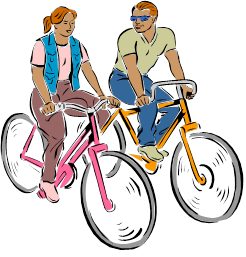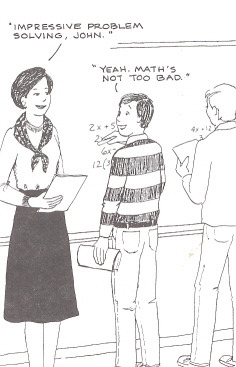A BICYCLE RIDE:
WHY WE NEED GROUPING
In the interest of enhancing our physical fitness, my husband and I decided we would do some daily bicycling. Mountain bikes were the appropriate vehicles for our hilly Wisconsin countryside since they provide 21 gears including a “granny gear” for the steeper climbs. I started our new activity after a fairly rigorous lap swimming regime. I considered myself reasonably physically fit. My husband had not been exercising regularly during the winter so I had some early stamina advantage.
 We rode off in the early morning together, learning the appropriate gear use and appreciating the spring renewal around us. On our first two or three mornings we were well matched and the biking felt like a reasonably social hobby. After less than a week, my husband’s strength and endurance far exceeded mine. My slow pace no longer provided sufficient physical fitness challenge for him. Since our prime reason for bicycling was fitness, I suggested he feel free to go ahead at his own speed. The five-mile course provided plenty of challenge for me, but he soon added two extra miles. We waved as we passed each other going in reverse directions.
We rode off in the early morning together, learning the appropriate gear use and appreciating the spring renewal around us. On our first two or three mornings we were well matched and the biking felt like a reasonably social hobby. After less than a week, my husband’s strength and endurance far exceeded mine. My slow pace no longer provided sufficient physical fitness challenge for him. Since our prime reason for bicycling was fitness, I suggested he feel free to go ahead at his own speed. The five-mile course provided plenty of challenge for me, but he soon added two extra miles. We waved as we passed each other going in reverse directions.
Our daughter, Sara, visited from college several weekends. She joined us and it was very clear that, thanks to her youth and condition, a fitness experience for her demanded more challenge than either of us wanted. Although we could ride together socially for a short time, if we were truly to provide ourselves with a cardiovascular workout, paces and distances would be different for each of us.
Reflecting on my felling of being left behind and my husband’s and daughter’s needs to bike ahead for fitness, I identified our biking experiences with the controversy that presently surrounds educational grouping in our schools.
First I imagined that not three, but twenty-three of us were biking on that country road. Then I asked myself many questions about my feelings. These seem to be questions which teachers and parents should ask themselves about grouping in the classroom. Please pretend you are biking with me and share my questions.
- Was the main purpose of our biking social or physical fitness?
- Would it have been possible for us to all meet our social and physical fitness goals with the same activity?
- How did I feel in being the slowest biker? Would I feel better if there were some other slow bikers near me?
- How would my husband and daughter have felt if I had asked them to slow their pace for me or to spend most of their time teaching me to bike better?
- How would I feel about myself if the more able bikers were to spend most of their time teaching me or slowing down to wait for me?
- Would the better bikers enjoy biking with persons with similar skills, strength and endurance?
- How could I feel good about my physical fitness activity even though I was the slowest?
- How would I feel if an outsider insisted that I keep up with the faster bikers?
- How would I feel if others did not see the value of my physical fitness activity for me?
- How would I feel if my fitness and strength improved but I was forced to continue to ride at my same speed and distance?
If you’ve wandered through my bicycle questions, please return to the same questions and pretend you are a student in a classroom. In each of the questions, replace physical fitness with educational fitness. Replace the word “biking” with “school.” Now answer those questions as they relate to classroom grouping.
- The primary purpose of school is not social, but educational fitness. We
 should not ignore the social, but there are many opportunities within the school and community for social life that will not invade on the importance of educational fitness.
should not ignore the social, but there are many opportunities within the school and community for social life that will not invade on the importance of educational fitness. - We can’t meet all students’ social and educational needs with the same activities. They can be better met by including grouping for some parts of the curriculum, but not grouping for others.
- No student would like to be considered the lowest in the class. Avoiding having small groups of slow readers with only two or three children will prevent that sense of their feeling like “losers.”
- Students who need more challenge resent teachers and other students who slow down their learning process. They legitimately feel bored in class and tend to feel superior to other kids if they spend their schooltime teaching instead of learning.
- Slower students hesitate to ask questions, volunteer and discuss if they feel like they are slowing other students down. Feeling like they’re slowing others down is not good for one’s self-concept.
- Very capable students do enjoy learning with intellectual peers and often miss the stimulation when peers are not available.
- Children enjoy the sense of learning if they feel they are making progress. Setting and reading personal goals is important for children at all levels.
- Children feel pressured if they are rushed beyond capacity.
- Children who are not viewed as achieving by parents and teachers don’t feel good about themselves. All students should feel the sense of accomplishment and the worthwhileness of effort.
- It’s important to show children paths for movement between groups, particularly upward mobility through effort. *
Based on relatively limited research, the concept of academic grouping is rapidly disappearing from classrooms throughout our nation. As we try to save children from feeling like “losers” in competition, we are taking from them some important coping skills they will need in our competitive society. For very bright children, we may be, in a very global way, asking them not to stretch themselves mentally. We may actually be preventing them from important learning during many of their school years.
It’s hard to predict the educational outcomes for these students who are being prevented from developing their mental fitness in order to fit in socially with their peers. We may recognize the loss only after an entire generation reaches college.
Other nations that value achievement are demanding much more mental fitness of their students. Their students will not pedal slowly to wait for our country’s students to catch up. A bicycle ride provides physical fitness only when all riders are encouraged to exercise to their abilities.
©2010 by Sylvia B. Rimm. All rights reserved. This publication, or parts thereof, may not be reproduced in any form without written permission of the author.
